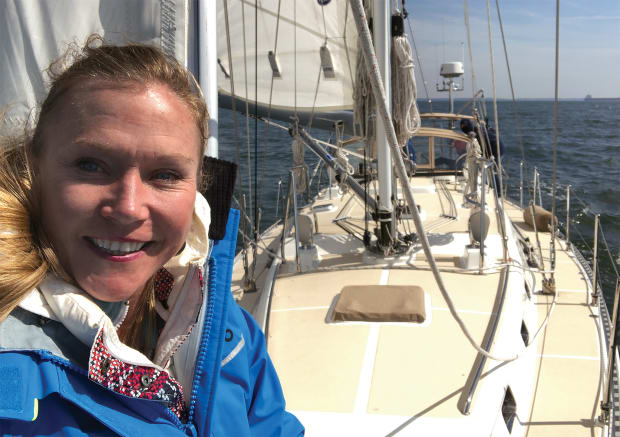
“Keep it simple, sailor,” was always our mantra. Aboard our 1985 Niagara 35, Plaintiff’s Rest, my partner, Phillip, and I didn’t have heat, AC, a hot-water heater, generator, watermaker or bow thruster, which meant we also didn’t have to absorb the costs and time required to maintain these kinds of complicated systems. Over the course of seven years, Plaintiff’s Rest’s simplicity also allowed us to learn her every nut, bolt and quirk, until we could fix pretty much any problem ourselves. Sounds perfect, right? Well, we recently sold her and bought a newer, more costly, harder-to-handle and far more complex boat. In short, we ditched our previous simplicity and went for broke. Go on, ask me: Why would we change tacks this way?
The answer: we found ourselves in a header. That old racing wisdom to tack on a header rings as true in life as it does in sailing. Things are always changing. The seasoned sailor must constantly monitor the conditions, consider their impact on her current course and adjust as needed. When you’re sailing upwind and the wind shifts toward your bow—a header—it will force you onto a heading farther away from your ultimate destination. When you come about, you change course to the tack that’s been lifted, so that you are once again on the most direct path to your end goal. Is it guaranteed the new wind direction will hold and your tack will prove to have been the right thing to do in the long run? Never. That’s all part of the fun of pitting your skills and senses against the constantly changing conditions to make them carry you to your end goal. Am I still only talking about sailing here? Or is this starting to sound like something a bit more general?
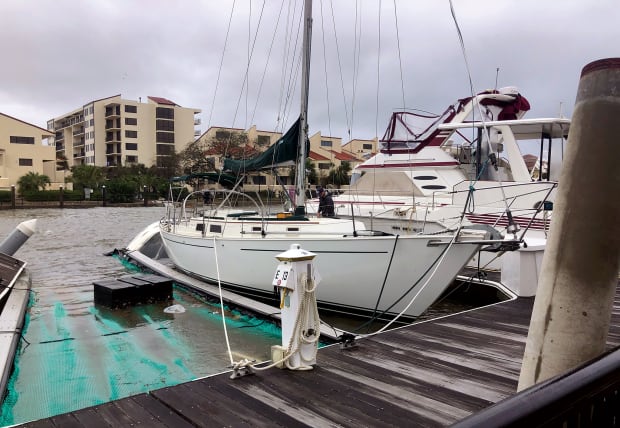
The Conditions
As was the case for so many, Covid-19 has forced us to acknowledge some hard truths. While Phillip and I had never before dreamed of ever giving up our Niagara, we had also never before dreamed we would find ourselves in the middle of a pandemic, with borders shutting down left and right and so much uncertainty. Seeing our fellow cruisers trapped aboard their vessels in the Bahamas and Caribbean, waiting for things to open up again with only limited supplies or options got us thinking. In the future, we realized, we would need a boat that would allow us to comfortably sustain ourselves for longer than we might have previously thought necessary in case we ever found ourselves someplace where we had to quarantine. Covid-19 changed “keep it simple” to “keep it sustainable.” This, in turn, opened our minds to the possibility of more complicated systems that can generate or store greater quantities of power, water and fuel.
Covid-19 also taught many of us that we really don’t need to go to an office and sit at a fluorescent-lit desk to do our jobs. Zoom was a huge shift in our world, allowing us to attend meetings virtually. Previously, Phillip and I had been more “commuter cruisers” than liveaboards, moving the boat in stages to various destinations as we flew back and forth to Pensacola, Florida, for work. We’d spend several months aboard full-time during the cruising season. But the rest of the time we’d return to going to the office again because that was just how things were done. Now with a boat that offered climate control and reliable internet, Phillip and I realized we could truly live and work aboard full-time, while at the same time traveling whenever and wherever we wanted. We questioned our own scandalous thoughts. Could we really? Is it finally time? That, of course, was another Covid-19 lesson. If the world is really and truly capable of changing as completely as it did in 2020, it matters more than ever how you live in the present. Whatever serious full-time cruising Phillip and I had merely hoped to do, the hoping was through. It was time.
Finally, there was Hurricane Sally, which ripped its way through Pensacola in September 2020, catching pretty much every sailor there by surprise and damaging and destroying many vessels. While Plaintiff’s Rest thankfully emerged in relatively good shape, she still needed some significant repairs, primarily to her rudder and hull. Sally also made obtaining insurance on the Gulf Coast far more difficult than before, further decreasing our tolerance for keeping a boat in the “hurricane box” that is the Florida panhandle for another season.
Phillip and I talked about sailing her to Trinidad in 2021, then perhaps New England in 2022, followed by a possible Atlantic crossing; however, Plaintiff’s Rest would definitely need some serious upgrades before we would be ready for that kind of adventure. Her engine, for example, is 38-years-old, and she would definitely need a re-power. Her autopilot had seen better days as well, and a watermaker could be a lifesaver. More solar would be nice, as would a lithium battery bank. We even toyed with the idea of installing additional tankage. Water? More diesel? Anything was possible. Costly, but possible. The problem was that if we did all of that, it would result in a vessel ready to cross oceans but incapable of returning the money we put into to. Six figures of our savings would have been laid into her like resin, impossible to recoup.
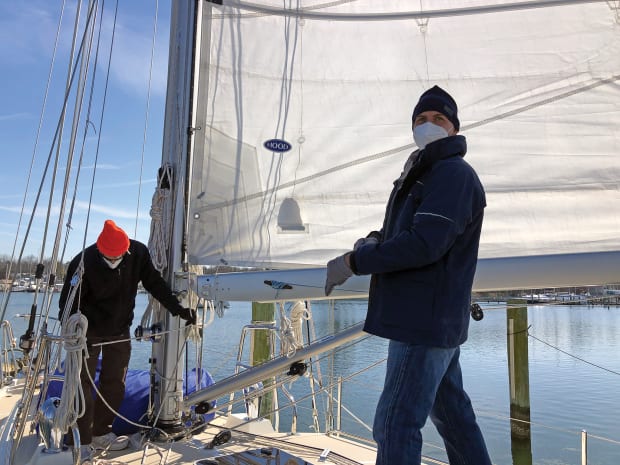
The Shift
By contrast, when you buy a newer boat, all these kinds of systems and “upgrades” come included. They also depreciate more slowly than if you bought them new and then installed them yourself, allowing you to recoup a greater percentage of your purchase price when it comes time to sell. Buying another, newer boat we would also be able to finance the purchase, if we wanted, to preserve our savings and keep our financial options flexible in case conditions changed: which again, Covid-19 has taught us all can happen at any time.
The thought of truly living and working aboard full-time also got us thinking about “a day in the life” on our current boat. If you saw life aboard our Niagara—heating water in a kettle for bucket showers, pulling our “water wagon” into town to buy/fill our freshwater jugs, filling and strapping a half-dozen jerries of diesel to the lifelines before each passage, breaking down and stowing the dinghy whenever it comes time to cast off—you might say “that’s cute.” And it was.
However, it was also time-consuming. Because of her limited tankage and overall simplicity, life aboard the Niagara is a good deal more rustic and daily chores end up taking a lot of time: time we would rather spend working and earning income. Assuming all of the fancy systems on a bigger, more complicated boat didn’t overly trouble us with any kind of maintenance or repair needs (fingers crossed!) a newer boat would offer us more time to spend the way we chose—be it on a Zoom call, out sailing or enjoying a cold beer.
Can you feel it? “There comes a tipping point,” Phillip said, and we were tipping. Our mental and emotional sails were beginning to luff as the wind shifted more and more toward our bow. Time to adjust course. Falling off would mean upgrading Plaintiff’s Rest, making an irretrievable investment in her and embracing a more basic version of life aboard for the indefinite future. Tacking, on the other hand, would mean finding a newer, bigger boat that would include the necessary systems to both live and work aboard in comfort and also travel quickly and safely across the Atlantic to the Azores, Portugal, Spain and the many other places on our seemingly endless list.
Whether to tack or not is always a tough choice. Are the conditions going to hold? Will things really be better n the other tack? In life, though, as in sailing, there are no pat answers or outcomes. In the end, Phillip and I simply weighed the pros and cons and then made the decision that felt right for us. “Ready about!” Phillip declared, and the next thing we knew were embarking on a whole new kind of adventure.
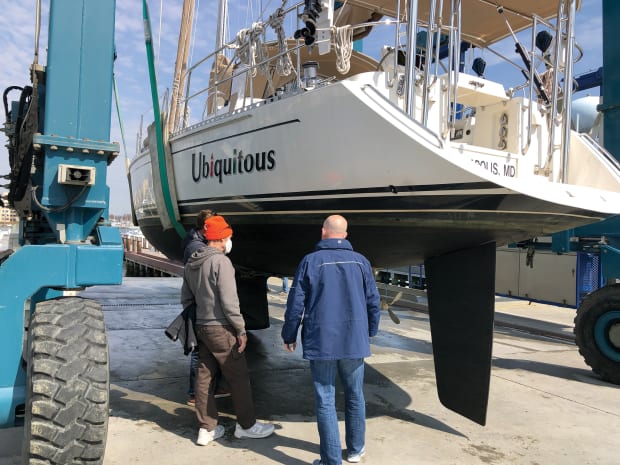
The Tack
“Hard alee!” This is the command that ushers in the ugliest phase of coming about, when your bow first passes through the eye of the wind and the sails all start popping and flogging. Our minds sounded just like that, clanging, banging and flopping from one potential new boat to the next. In the hunt, we considered a number of slightly used and newly built, Tartans, Hallberg-Rassies and even, for a brief moment, an aluminum-hulled Ovni 40. Eventually we landed on the Outbound 46. This is not a mass-production boat. The company generally only builds one or two a year, because it builds them right. The boat is also specifically designed to be handled by a cruising couple. Company founder Phil Lambert commissioned the design from Carl Schumacher, with the idea that every feature is both capable and comfortable. One word sold us: moderation. Lambert wanted a boat that would be exceptionally strong, with a fully-glassed hull and encased keel, but also a sailing machine. Schumacher came through with a moderately proportioned design with a draft, beam and mast height all specced to create a boat that is, on the one hand, a fun daysailer and, on the other, a capable ocean-crosser and a spacious, liveaboard.
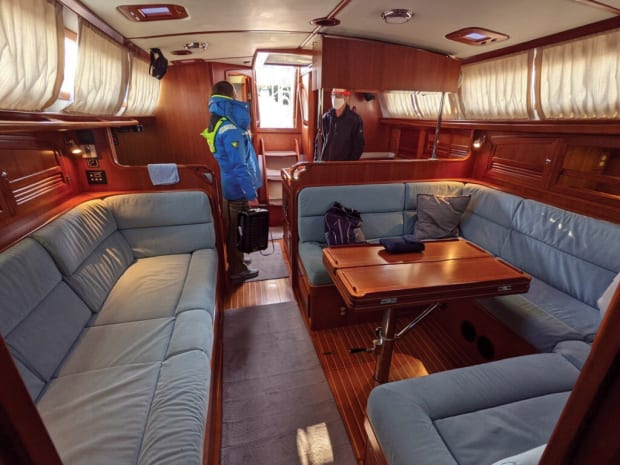
As a practical matter, the boat we had our sights on also offered 200 gallons of water tankage, a watermaker, a water heater, a diesel heater, 190 gallons of fuel, a new lithium battery bank, 200W of solar panels, a wind generator, a DC generator and air conditioning. The creature comforts were dazzling, as was the dedicated workshop in the starboard lazarette that made this grease monkey’s jaw drop.
Other features included clear visibility from the helm, locking floorboards, a crash bulkhead in the bow and an island queen bed in the V-berth. Every element spoke to an unfettered commitment to moderation, while offering the safety and convenience of a boat that can make 7-10 knots easily and comfortably: doubling the speed we typically made aboard Plaintiff’s Rest, and thereby also cutting the time it would take to run from a storm or make a dicey passage in half.
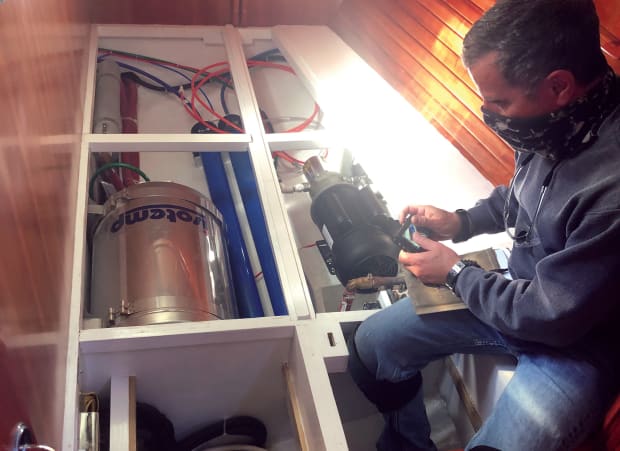
The Lift
Once we’d settled on the Outbound 46, we were lucky in that our Outbound had little trouble finding us. She was the only—only!—Outbound 46 for sale in the entire world that was not under contract at the time. We soon learned that when it comes to Outbounds there are two places they don’t stay: on the dock or on the market. Outbounds are coveted and clung to. Serendipitously, some twist of sailor’s fate dropped the only available Outbound 46—Ubiquitous, 2015, hull #58—right in our path. She also surveyed and sea-trialed exceptionally well and successfully passed a meticulous pre-purchase inspection by Steve D’Antonio (of Steve D’Antonio Marine Consulting Inc., stevedmarineconsulting.com), a move I highly recommend. Finally, Phillip and I were fortunate in having found a former owner whose care and maintenance of the boat were not only exceptionally thorough but thoroughly documented.
After we closed on Ubiquitous, it was as if we had also, finally settled in on our new tack. The sails filled taut, and we are now quickly and comfortably riding the lift toward our end goal of living aboard and cruising full-time. Will the wind hold? Will the coming months and years prove we made the right decision coming around onto this new course? Ask me when I’m, say, working on the hot water heater aboard Ubiquitous next year in what we’ve already named “Annie’s Shop.” The good news is, even if I can’t get the darn thing working that day, Plaintiff’s Rest did a great job teaching us how to get by without all of those fancy systems. When needed, we still know how to keep it simple. “Get the kettle,” I’ll tell Phillip, “and the bucket.”
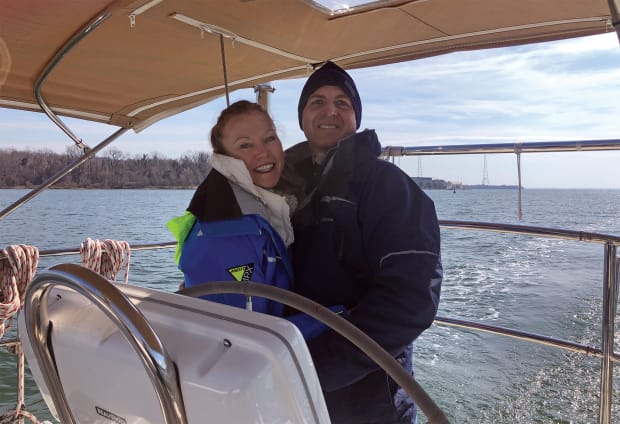
Photos by Annie Dike
March 2022








